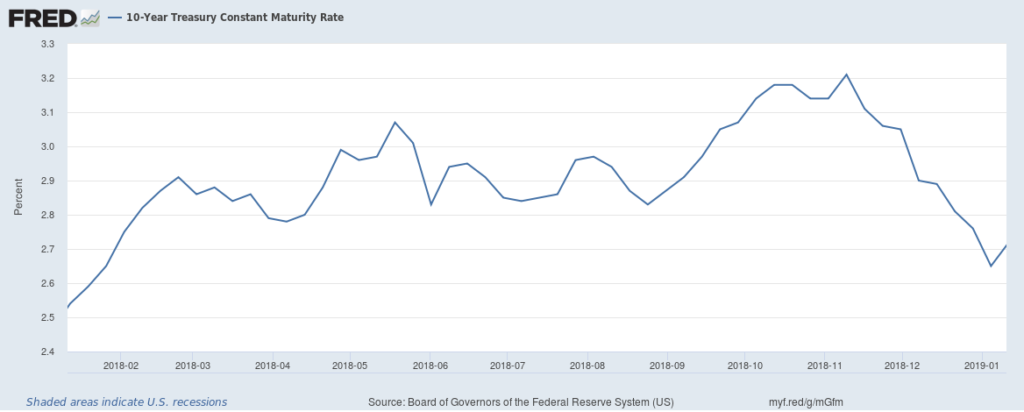One of my New Year’s resolutions is re-starting the blog. Little Bear is at 16 months, still a bundle of fun, and a bit less work. I’ll probably focus more on Economics/Markets, but range around as before.
I am more than little perplexed by current commentary around the Fed’s QT (Quantitative Tightening) program. This keeps coming up as a cited cause of market’s recent sell off.
That would be fine if QT had followed expectations by driving Treasury Interest Rates UP. But the 10 year bond yield has gone DOWN since the Fed started QT’s planned shrinkage of their balance sheet in October.

Before-the-fact commentary expected exactly the opposite. All the QT commentary I can find predicted lower Fed buying would drive up interest rates (and challenge the market). As we go into October, rates went down. Low rates are usually seen as helping not hurting risk-asset markets. Although commentators have stuck to QE as a cause of the market’s troubles.
Something here doesn’t add up. I don’t have a definitive answer myself. I do have some ideas.
- A crowd surge over-powered any (relatively weak) real world QT impact? The market created a self-fulfilling prophecy keyed to the start of QE. “Everyone” expected higher rates and planned to pull back accordingly – shifting into safe assets. That buying surge would explain the drop in yields (driven by an increase in demand for safe 10 year Treasury assets). Any real impact of QT got swamped by that wall of money. In that scenario, we could have a pretty big market rebound once everyone goes home and changes into clean underwear.
- QT is (and always was) a red herring just like QE? Arguably QE didn’t do much and the unwinding of it (QT) isn’t doing much either. As Ben Bernanke said in 2014 “The problem with QE is it works in practice but it doesn’t work in theory.” In practice, QE did boost animal spirits. But the theory pat matters. It isn’t clear QE had much real impact on market interest rates (especially long-term rates). QT might not be doing much either. That debate is above my pay grade, but a relatively weak QE/QT effect would square with the “market over-reaction” scenario above.
The real culprit may lie (conveniently forgotten) in the recent past. The failure of the US tax cuts to deliver meaningful long-term stimulus. Lower corporate rates gave us a one year earnings boost, but no real economic boost. The market drop may reflect that US just fired most of its fiscal stimulus bullets funding a huge tax cut into an already-booming economy. Leaving it that much more vulnerable when the next downturn comes.
Why blame QT instead of a failed stimulus?
- Blaming QT helps us pretend someone is in charge. I always find it odd that Wall Street clings so hard to faith in the Fed. Markets are scary, uncontrolled places. Its easier to sleep at night believing the Fed has the helm. This ignores that the Fed has been pushing up short rates with dismally little impact on long rates so far. Which may suggest the Fed’s wheel is turning the wheel, but the rudder’s broken off. That is a scary thought, but it seems to fit the facts.
- Blaming QT avoids a lot of politically awkward questions. If you acknowledge the tax cuts failed, you risk the general conclusion that taxes are a lousy stimulus mechanism. You end up bolstering the argument that deficit spending on affluent people (who save it) isn’t nearly as useful as spending on poorer folks (who spend it). And that is political anathema to most (affluent) investors. Much better to blame QT instead.
Out in reality, however, the situation looks both encouraging and dire.
- The market tantrum might be no more than that. There are certainly headwinds and risks, but the economy seems to be generally chugging along. By mid-year, all may be forgotten. Rates remain low. It is risk-on again.
- But, when the downturn does come, the US has very few bullets in the gun. The Fed can’t raise rates any further. So it won’t have much room to cut. Negative rates are a political impossibility until things get really bad. On the fiscal front, we just blew out the deficit on an ineffective stimulus. And too many people cling to a belief in tax cuts evidence be damned.
In the short term, the Fed seems likely to pause and unlikely to do much if any rate raising thereafter. Especially as they can’t raise rates much without intentionally inverting the yield curve. Unless the market (and long-term rates) shoot up. Besides, the Fed’s behavioral model seems to be “raise rates until something breaks.” Something just broke. So mission accomplished.
In the meantime, those market-driven long term rates remain stubbornly low. This is the most scary thing out there IMHO – implying low growth, deflation, or both. It is also worrying that (market-driven) long-term rates are showing no inclination to follow the Fed. A broken rudder is a scary thing in any scenario.
In the short term, however, low rates make riskier assets attractive. Earnings multiple relative to those low long term rates look fine. Especially if you have a return target of 5%-7% in a world where risk-free returns are around 3%.
So maybe we go back to “risk-on.” Wary of when we finally do meet a bear. With very few bullets in the gun. But in the meantime, the music’s still playing. So we keep on dancing.
Cheers.

